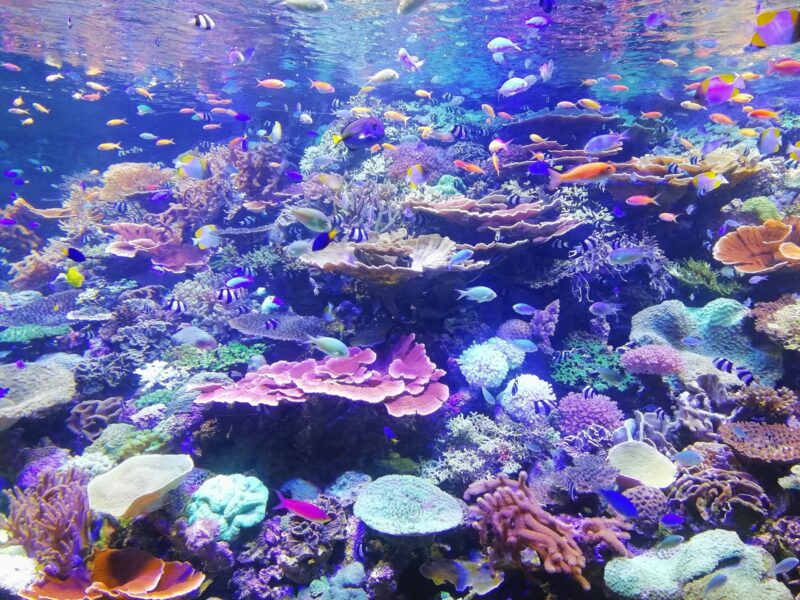Table of Contents
ToggleTop Underwater Cameras: Overview
Exploring the underwater realm has always been a fascinating endeavor, captivating the minds of divers, marine biologists, and underwater photographers. Modern advances in technology have made it possible for you to capture vivid images and videos of this mysterious world with the help of underwater cameras. These underwater cameras are designed to withstand submersion and pressure, offering an array of functions tailored for aquatic photography. From the colorful coral reefs teeming with marine life to the solemn shipwrecks resting on the sea floor, underwater cameras allow you to document these moments and share them with the world.
When considering underwater cameras, assessing the device’s durability, image quality, and ease of use under water is essential. Equally important are the depth rating, which dictates how deep the camera can go, and the battery life, ensuring you don’t miss out on capturing a moment due to a dead battery. Additional factors such as lighting adjustments and lens compatibility come into play when striving for those perfect underwater shots.
In summary, your underwater camera should be a reliable companion that can capture and withstand the depths of your adventures. With the right camera in hand, you are ready to document the wonders of the marine world. From the kaleidoscopic beauty of coral reefs to the nuanced dance of aquatic creatures, the ocean’s depths hold endless photographic potential. After meticulous evaluation and testing, we’re here to guide you through the top picks for underwater cameras that promise to bring your underwater experiences to the surface in stunning clarity and color.
Top Underwater Cameras
AKASO EK7000 Action Cam
If you’re seeking an affordable underwater camera that doesn’t compromise on quality, the AKASO EK7000 could be an excellent choice for your aquatic adventures.
Pros
- High-resolution video and photo capture
- Includes convenient wireless wrist remote
- Comes with two rechargeable batteries for extended use
Cons
- Remote is not waterproof
- Wi-Fi connectivity range may be limited
- Battery life may be shorter than expected under certain conditions
Exploring an underwater scene with the AKASO EK7000 feels seamless, thanks to its 4K video capabilities. Vibrant fish and intricate coral come alive in the footage without the usual grain that plagues many other underwater cameras at this price point. The wrist remote is a game-changer, allowing you to start and stop recording without fiddling with the camera itself – a real asset when you’ve got your hands full, literally, with dive gear or paddles.
Handling the AKASO EK7000 is a breeze due to its user-friendly interface. Connecting it to your phone allows you to share your underwater encounters with friends almost as soon as you’re back on dry land. However, make sure you’re within the limited range for Wi-Fi connectivity to work effectively. The camera’s versatility impresses me every time, effortlessly transitioning from underwater to topside filming with its waterproof housing.
The durability of the AKASO EK7000 is notable, especially when enclosed in the protective case that shields it up to 98 feet deep. Concerns about battery life are alleviated by the inclusion of an extra battery, meaning you can swap them out during your surface interval and never miss a chance to capture the wonders below the waves. Though, remember to plan your dives according to each battery’s recording time to avoid disappointment.
KODAK PIXPRO WPZ2
If you’re seeking a sturdy camera for your aquatic adventures, the KODAK PIXPRO WPZ2 serves as a reliable partner.
Pros
- Resilient design withstanding water, dust, and drops
- Built-in WiFi for quick image sharing
- User-friendly for amateur photographers and casual use
Cons
- Image quality may not satisfy professional needs
- Low light performance could be underwhelming
- Battery life might limit extensive shooting sessions
Venturing into the marine world with the KODAK PIXPRO WPZ2 at hand was an enjoyable experience. Its waterproof capabilities allowed me to capture the underwater landscapes without worrying about damage. The camera’s rugged design shrugged off sand when I inadvertently set it down on the beach, and it absorbed the shock of a minor tumble with no visible harm.
The ease of use stood out; operating the PIXPRO WPZ2 felt intuitive. The WiFi connectivity also proved its worth, as I was able to send shots of the latest undersea finds to my friends without delay. The WPZ2’s affordability means you’re not constantly fretting over potential loss or damage, unlike when caring for a high-end camera.
On the downside, while the photos were vibrant and clear in sunny, outdoor conditions, the image quality didn’t quite hold up in dimmer environments during a twilight dive. Furthermore, the battery seemed to dip quicker than I expected, which is something to keep in mind during longer excursions. Remember to pack a spare battery or plan for a recharge.
Overall, the KODAK PIXPRO WPZ2 is a solid choice for those wanting to document their wet and wild journeys without the financial and emotional investment that typically comes with more expensive equipment.
IceFox Action Cam
If you’re seeking a reliable and budget-friendly underwater camera that offers high-resolution imagery, the IceFox Action Cam is a sensible choice.
Pros
- Impressive underwater housing capable of withstanding depths of up to 130 feet
- Clear, intuitive touch screen that simplifies navigation and camera use
- Generous battery life for extended recording sessions, courtesy of two included batteries
Cons
- The actual video resolution may not consistently meet expectations for 4K quality
- Some found the camera’s performance to be lacking compared to higher-end models
- Limited to a 170-degree field of view which might not suit those desiring a wider angle
After recently taking the IceFox Action Cam for a spin, I found its sturdy build quite reassuring, particularly when submerged during a snorkeling trip. The camera’s user interface, facilitated through a responsive touch screen, was a pleasure to use underwater. Everything was at my fingertips, allowing for swift mode transitions.
The camera’s storage capacity is not to be underestimated. Having the ability to record on up to a 128GB micro SD card meant worrying less about space and more about capturing the beauty of the aquatic life. Snapping photos with the 20MP camera produced some truly vibrant shots worth sharing.
Coming with a plethora of accessories, you won’t find yourself lacking in ways to mount or protect the IceFox Action Cam. The long-running battery life truly came in handy on a full day’s adventure, letting me record without frantically searching for places to recharge. However, while it does boast a 4K capability, professional videographers or those with a keen eye for detail may notice the quality isn’t on par with high-end underwater cameras. Nevertheless, for its price point, the IceFox Action Cam is an admirable performer, especially for beginners or those needing a rugged companion for their outdoor activities.
AKASO EK7000 Action Cam
If you’re seeking an underwater camera that balances cost and performance, the AKASO EK7000 could be your go-to gadget.
Pros
- High-resolution 4K video capture
- Convenient remote control wristband
- Generous battery life with dual batteries
Cons
- The remote isn’t waterproof
- Wi-Fi connectivity range is limited
- Some users report a steep learning curve
After taking the AKASO EK7000 for a swim, I found the video quality to be quite impressive. The clarity of 4K video at 30 fps allowed me to capture the underwater scenery in crisp detail. It’s a welcome addition to my snorkeling trips, preserving moments in high definition that I can relive anytime.
Using the camera underwater worked like a charm. Having a waterproof case that stands up to depths of 98 feet meant that I could explore without worrying about damaging the camera. It handled the pressure well, and not once did I feel concerned about leakage.
The capability to control the camera remotely made it much easier to snap pictures while snorkeling. Framing my shots was as simple as pressing a button on the wristband. However, remember to remove the remote before diving in since it won’t survive a dip.
As for battery life, it didn’t disappoint. I was able to document my full diving session without worrying about running out of power, thanks to the spare battery. Swapping batteries is straightforward, and back on dry land, I appreciated the ease of sharing my footage with built-in Wi-Fi, despite occasional signal drop-offs when I strayed a bit too far from my connected device.
Navigating the settings initially took some patience. There’s a slight learning curve to mastering the functions and getting the most out of the high-quality capture options. But once you get the hang of it, the AKASO EK7000 proves to be an invaluable tool for underwater adventures.
GKTZ Kids Underwater Camera
This camera is a hit for young photographers looking to capture their aquatic adventures with ease.
Pros
- Easy to handle and resilient against drops and submersion in water, perfect for active kids
- Rotatable lens allows for versatile shooting angles and selfies, sparking creativity
- Good battery life and included 32GB SD card means plenty of uninterrupted fun
Cons
- Digital zoom may limit picture quality compared to optical zoom options
- May not be as straightforward for younger children without parental guidance
- Durability in harsher underwater environments could be a concern over time
After spending some time with the GKTZ Kids Underwater Camera, I found it to be a trusty companion for the pool or beach. The protective case is a real game-changer; it withstood a few tumbles and continued to perform admirably under water. The kids seemed delighted with the freedom to snap photos from any angle, thanks to the 180-degree rotatable camera. Even after back-to-back use during a family outing, the camera’s battery kept up without a hitch, which is a big plus for any day trip.
There’s a noticeable difference when kids transition from using a smartphone to this camera. The simplicity of two-button operation is well-suited for their small hands, and they particularly enjoyed embellishing their photos with the playful filters and frames. As someone who’s witnessed plenty of gadgets succumbing to the trials of parenthood, I’d say the GKTZ camera’s resilience is commendable.
But no product is without its limitations. For one, the reliance on digital zoom might not meet everyone’s expectations for image quality, especially at maximum zoom levels. While children generally don’t fuss over pixel count, it’s something to keep in mind if you’re looking for pristine images. And while the camera is user-friendly overall, its interface may initially confuse the younger users until they get a hang of it.
In conclusion, the GKTZ camera is designed with a child’s rough and tumble lifestyle in mind. It’s not just a gadget; it’s a tool that encourages them to explore and document the world around them, even underwater. Sure, it might not be a professional’s choice, but for kids ready to dive into photography, it’s a solid start.
YEEIN 16FT Underwater Camera
If you’re dipping into underwater photography, this starter camera merges ease of use with the thrill of oceanic exploration.
Pros
- Admirably resistant to water pressure at depths of up to 16 feet
- Included floating strap avoids accidental losses during aquatic adventures
- Generously bundled with a 32GB card for extensive photo storage
Cons
- The still resolution of 8 MP falls short for detail-oriented shooters
- Limited optical zoom restricts close-up shots of distant marine life
- Some users report occasional charging issues, affecting reliability
Diving into underwater photography has never been more approachable with the YEEIN 16FT Underwater Camera in hand. The moment it’s submerged, it becomes a portal to a vivid aquatic world. Its buoyant strap means one less thing to worry about as you’re free to swim and capture the wonders without the fear of losing your device to the depths.
The camera’s simplistic design ensures you aren’t fumbling with controls beneath the waves. You’ll appreciate how quickly you can go from observing a stunning coral scene to having it digitally captured and safe on your included memory card. The ability to shoot continuously is a boon for capturing fast-moving subjects in an environment where every second counts.
However, be mindful of its limitations. The 8MP resolution is ample for casual keepsakes but may not satisfy those after gallery-quality images. The visual range is a bit constrained with its scant optical zoom, possibly leaving those mesmerizing yet shy sea turtles just beyond your photographic reach. If you encounter any power issues, make sure to troubleshoot well before any anticipated underwater escapades.
AKASO Brave 4 Action Cam
If capturing underwater adventures with vivid detail is your goal, this camera is a reliable and affordable choice.
Pros
- Smooth video quality with built-in stabilization
- Easy sharing with Wi-Fi and HDMI output
- Generous bundle of useful accessories
Cons
- Limited optical zoom capability
- Moderate learning curve for best results
- Battery life may be short for extended outings
Exploring the deep blues has never been easier. With the AKASO Brave 4, I effortlessly captured the marine life in stunning 4K quality. The gyro stabilization ensured that even when I was riding the waves, the footage remained smooth and professional.
Taking it for a spin while snorkeling, I found the Wi-Fi feature incredibly handy for quickly sharing snapshots of the vibrant coral reefs to my phone. The HDMI connection came in useful for reliving the day’s journey with friends on the big screen. The versatility of the viewing angles allowed me to experiment with different perspectives, a creative liberty I truly appreciated.
Between dives, changing the dual batteries was a breeze, and they charged conveniently through the USB dual charger. Although I had to be mindful of battery life, carrying the spare was a small trade-off for the chance to record over an hour and a half of underwater escapades. The remote control was a nifty addition but remember, it can’t dive with you!
This camera stood up to the challenge, providing vibrant footage and stills of my aquatic explorations. With its comprehensive set of mounts and accessories, it seamlessly became a part of my dive gear ensemble, ready to brave the elements alongside me.
Apexcam 4K Action Cam
Embrace aquatic adventures with confidence, this Apexcam 4K Action Cam delivers high-quality visuals and versatility underwater.
Pros
- Impressive 4K video capabilities for the price range.
- A wide array of accessories and two batteries included.
- The 40m water resistance is ideal for most water sports.
Cons
- The image quality may not meet expectations in low-light conditions.
- Limited wireless remote control range can be restrictive.
- Some users report issues with continuous recording functionalities.
On a recent snorkeling trip, the Apexcam 4K Action Cam was an exciting addition to the gear. It captured the vibrant underwater world in striking detail, and the 170° wide-angle lens meant not a single moment was missed. Handling the camera was a breeze; it’s compact and unobtrusive, allowing for more freedom while swimming among the fishes.
The wireless wrist remote control added a level of convenience when the camera was mounted on the head-strap, and not once did I need to fiddle with the camera mid-dive. Being able to frame shots with the 2.0” LCD screen was particularly useful, checking the captures instantly kept the focus on the underwater experience, rather than the technicalities of filming.
While the Apexcam provided lots of enjoyment and decent footage, there were instances when it fell short. Recording in an environment with less than perfect lighting resulted in grainy footage. And although manageable, the limited range for the wireless remote necessitated occasional closeness to the camera that wasn’t always feasible.
Back on the boat, sharing the day’s captures was a snap with the built-in WiFi. I could easily connect to a phone or tablet, uploading impressive shots to social media, garnering likes and comments from friends amazed by the undersea clarity.
In summary, the Apexcam 4K Action Cam offers great value for those looking to capture their underwater escapades without breaking the bank. Its ease of use and respectable video quality make it a solid choice for beginners and enthusiasts alike seeking an affordable underwater camera.
Fujifilm QuickSnap Waterproof Camera
Enjoy capturing your underwater adventures with ease using the Fujifilm QuickSnap Waterproof Camera, perfect for those wet and wild moments.
Pros
- Simple operation with a large shutter release
- Pre-loaded with high-quality Fujicolor film
- Functional down to 35 feet underwater
Cons
- Limited to 27 exposures
- Not reusable once the film is finished
- No manual control over settings
This camera offers an approachable solution for underwater photography. Its ease of use is striking; you simply need to point and shoot to capture vibrant memories beneath the waves. The larger shutter release is extremely practical, allowing for smooth operation, even with wet hands or gloves.
There’s no fumbling with settings, which is a welcome feature when you’re amidst the flurry of an exciting snorkeling session. Thanks to the camera’s pre-loaded Fujicolor Superia X-TRA 800 film, the photos you capture have a classic film quality that’s increasingly rare in the digital age. The tactile experience of shooting with film and anticipation of developing your shots add to the overall enjoyment.
However, the disposability of the Fujifilm QuickSnap Waterproof Camera controls its lifetime to a single use. Those 27 exposures are precious, so each shot must count. Additionally, the lack of control over the camera settings may leave photography enthusiasts wanting more flexibility. And yet, it serves its purpose admirably, bringing analog charm to your underwater adventures without the fear of damaging your more expensive equipment. It’s one of the best budget-friendly underwater cameras on the market.
Buying Guide for Underwater Cameras
Key Features to Consider
When you’re looking to purchase an underwater camera, there are essential features to consider:
- Durability: Look for underwater cameras rated for significant depths and ensure they have a sturdy build.
- Image Quality: High resolution and good low-light performance are vital for clear underwater photos.
- Battery Life: Long battery life is crucial as changing batteries underwater isn’t feasible.
Camera Type
Your choice will depend on the intended use:
- Action Underwater Cameras: Compact and easy to handle, suitable for dynamic underwater activities.
- Compact Underwater Cameras: A balance between size and image quality, good for casual photographers.
- DSLRs and Mirrorless Underwater Cameras: Offer the best image quality and customization but require a waterproof housing.
Important Specifications
Consider these specifications to find the best fit for your needs:
| Feature | Importance |
|---|---|
| Waterproof Depth Rating | Ensure the camera can withstand the depths you plan to dive. |
| Megapixel Count | Higher megapixels can mean better-detail photos but also consider sensor size. |
| Manual Settings | Ability to adjust settings for different underwater conditions. |
Additional Considerations for Underwater Cameras
- Lens Options: Look at the availability of wide-angle or macro lenses.
- Storage Capacity: Make sure the camera supports adequate storage for your dives.
- Connectivity: Options for wireless transfer can be convenient for sharing photos quickly.
Underwater Cameras: Frequently Asked Questions
In this section, you will find specific information addressing common queries regarding underwater cameras, from key features to maintenance advice.
What are the key features to look for in professional underwater cameras?
When choosing a professional underwater camera, you should prioritize image quality, manual control options, depth rating, and robust housing to withstand pressure. Durability and battery life are also critical.
How do waterproof cameras differ from underwater cameras?
Waterproof cameras are typically designed to handle submersion in water for limited depths and durations. Underwater cameras, however, are built specifically for sustained use at greater depths and often come with advanced features for diving conditions.
How can I determine which underwater camera is best for snorkeling?
The best underwater camera for snorkeling is one that balances good image stabilization, ease of use, and a suitable depth rating for shallow water, such as the Olympus Tough TG-6 or the SeaLife Micro 3.0.
Are high-end underwater cameras significantly better than cheaper options?
High-end underwater cameras often possess superior sensors, better low-light capabilities, and higher-quality lenses, which can significantly enhance image quality and performance compared to cheaper models.
What maintenance is required to keep underwater cameras in good condition?
Regular maintenance for underwater cameras includes rinsing it with fresh water after each use, checking O-rings and seals for debris, and ensuring that all compartments are dry before opening. Proper storage away from extreme temperatures is also essential.



















